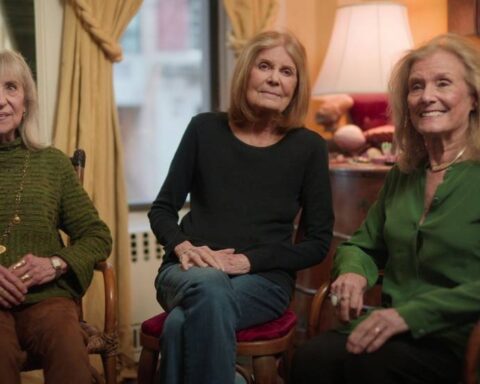It’s funny, the things that you remember. While I couldn’t say just what was on the docket during my first introduction to Cinema studies class at the University of Toronto in September of 2000—probably something about Citizen Kane, which had screened the day before to pockets of knowing giggles from kids who had absorbed its key moments through the cultural osmosis machine called The Simpsons —I do recall the lecturer’s genuine surprise when he looked up and saw a full house in Innis Town Hall. “What are you people doing here?” he asked. “Isn’t there a film festival going on down the street?”
Indeed there was, and before the week was out, I had skipped several classes (including a few affiliated with other faculties) in favour Toronto International Film Festival (TIFF) screenings, which were taking place in Yorkville or at such downtown cultural buildings as Roy Thomson Hall, the Art Gallery of Ontario (AGO) and the Elgin Theatre. I justified these excursions as an unofficial complement to my “official” education—less a dichotomy than a dialogue, or maybe cinema studies by other means. The proximity of campus to TIFF Cinematheque (formerly Cinematheque Ontario), located at the AGO, lent some ballast to this balancing act. Nine years later, after embarking on a career as a film critic, I returned to Innis to work on my Master’s degree. Once again, I found myself drawn to the festival bustle during the first week of classes, this time encouraging the undergraduates who came to my TA (teaching assistant) hours to think about wandering in the same direction.
While TIFF and the Cinematheque screenings take place at multiple venues in Toronto, the organization’s headquarters have been at 2 Carlton Street. It’s an office building, which has been home to both the parent organization and the Film Reference Library, which houses the world’s largest collection of Canadian film-related materials. But when I went there on a rainy day in October for a series of interviews with TIFF staffers, the conversations kept drifting towards the corner of King St. and John St. and the building that will be opening there in about a year’s time.
These digressions are understandable. In addition to becoming TIFF’s new operational headquarters and Ground Zero for TIFF, The Bell Lightbox is being sold as a pivot point for a number of educational initiatives. “One of the confusions that we’ve had is people asking us why we’re building a movie theatre,” says Noah Cowan, who has served as the building’s artistic director since the end of 2007. “I tell them that we’re not building a movie theatre, we’re building a learning institution.”
“The initial impetus behind the building,” he continues, “was sheer capacity. We had run out of seats at the AGO for Cinematheque, and we’d run out of screens at the multiplexes that were hosting Sprockets. Not to mention the fact that we have a library that’s become increasingly important but has become tucked away in a dilapidated office building. As we’ve been developing programming for the building, each aspect [of the company] has undergone an examination to see how we can strengthen the educational experience.”
Sprockets, which celebrated its tenth anniversary last year as Canada’s pre-eminent festival of cinema for children, would seem to already have pretty strong foundations. I’ve always been struck by how its programmers have managed to maintain an international focus while mostly keeping their distance from North American studios and distributors who would surely relish the opportunity to peddle their product at an event with an annual audience of more than 15,000 children and their parents.
“One of things that we’ve always tried to do is provide an alternative,” says Allen Braude, TIFF’s Co-Director of Learning. “One parent put it to me best when she said that while she didn’t have a problem with the cinema that was out there for her kids, she also wanted them to have diversity and choice. She told me that she felt that because of Sprockets, they were going to see stuff that would not have been otherwise available. Just seeing something from another place can be eye-opening and engender curiosity and interest and an open-mindedness which, as they mature, might make them more likely to examine other [films].”
Of course, Sprockets also has a more explicitly educational mandate, which manifests itself in its annual line-up of guest speakers, post-screening discussion groups, student workshops and youth programmes like the Sprockets Young People’s Jury Contest, which encourages children between the ages of 8-12 to think and write critically about cinema (no small thing when even grown-up film critics are starting to whittle their work down to Twitter-sized chunks).
“Attending Q&A’s with children is a refreshing experience,” adds Braude, who also works as the host of TIFF’s Reel Talk subscriber series and is thus equally accustomed to fielding film-related inquiries from an older crowd. “I find that with adults, the questions are often just a way for an audience member to show how much he or she knows about something. Kids really ask questions, and they ask about whatever is on their mind. And what they’re asking for is insight into how things are actually made.”
Hands-on expertise is also the underlying principle for Special Delivery, which aims to bring film—and filmmakers—to underserved communities in the GTA. “I wasn’t around for the first iteration of Special Delivery,” says TIFF’s Special Projects and Outreach Manager Emily Scheer, “but [when it started] it was just a small series of events. Now it’s a year-round initiative, with screenings and film-related workshops in what would be considered high-priority neighbourhoods in Toronto. The goal is to create a closer connection between filmmakers and the communities that they’re visiting, and so our programming tries to reflect the stories in those communities.” She cites Oscar nominee Hubert Davis, whose excellent 2007 short Aruba orbits issues of domestic tension and violence as a filmmaker whose participation went over especially well, and adds the programme’s reach should increase in light of Lightbox. “In future, when we have the headquarters, we could bring students down to see a classic Canadian film, but the scope of all that is a bit daunting at the present time.”
Still, Special Delivery took a significant step forward with a recent tour of schools in Northwestern Ontario—taking a cue, perhaps, from TIFF’s longest-running and most visible example of cine-pedagogy. 2009 is the 15th anniversary of Film Circuit, the cross-country screening series that endeavors to bring vital contemporary Canadian and international films to communities beyond the reach of most theatrical distributors. “The original ambition was to get Canadian audiences to watch Canadian films,” says Karen Black, TIFF’s Director of Canadian Initiatives, who joined Film Circuit as a volunteer in 2002. She estimates that approximately 30% of the films programmed by Film Circuit are Canadian, although that’s not a hard number.
“It used to be,” she continues, “that only a town with a theatre could be in the Film Circuit group, but now you don’t need one—we don’t think that people should be denied access just because there’s no theatre.” She says that while Film Circuit’s methods of exhibition vary from location to location—with some groups operating out of art galleries, museums and community centres—the common denominator is an attempt to contextualize and inform about the films on offer. “100% of our screenings have an introduction,” she says. “In every case, a committee member addresses the audience in advance. Many groups circulate newsletters and information about films, including some ‘heads ups’ about content.” This last note might suggest that Film Circuit’s programmers shy away from scheduling more difficult films, but Black says that this is not the case. “Once [our committee members] think that they know what their audience wants, our job is to challenge them, to start pushing them to broaden their horizons.”
“Education is all about exposure,” adds Tammy Stone, who was Film Circuit’s programming manager until late 2009. “We can programme films that we might not love, but that we think will work for our audiences. And we always get calls from people saying ‘we’ve never seen anything like this,’ or ‘this film changed the way we think about a certain topic.’” Stone laughs when asked about the tenor of post-screening Q&As in communities that are smaller and less ostensibly “film-literate” than Toronto (which would basically be every other city in Canada). “It’s exactly the same,” she says. “People everywhere have a basic curiosity about film, because it pervades our entire culture. People respond to the magic of movies, but they also want it deconstructed.”
Like Black, Stone emphasizes the value of having introductions and guests, but also believes that audiences are well capable of initiating and extending that deconstruction themselves. “I call it an impromptu educational environment,” she says, referring to the post-screening discussions that continue long after the hall has been emptied.
Stone also hints that simply going to a theatre to see a movie is a significant gesture at a time when many devoted film lovers and students of cinema seem bent on a more hermetic approach. Her thoughts are echoed by Bart Testa, the Senior Lecturer in Cinema Studies at the University of Toronto. “The mode of reception of films in our culture has partaken of a massive delusion,” he says. “The belief is that you can somehow get a film education by means of the internet or YouTube or a DVD store, which presupposes that the entire history of the cinema is a synchrony, waiting at your fingertips. it isn’t the same to watch a film at home as it is to watch it in a hall lwith 200 people.”
Testa says that TIFF Cinematheque is “a fantastic resource,” but notes that its audience tends to skew older, something that was also apparent to me when i started regularly attending screenings in early 2000. “Kids are busy and nervous,” says Testa when asked why many Cinema Studies undergrads—and graduate students—seem reticent to patronize an institution with such obvious benefits. “The idea of accumulating knowledge over the long haul is not part of student culture. students come in and they want to have it all subcutaneously injected into them. They’ll put up with a considerable amount of pain in the short term; what they need to understand is that [cinephilia] is a lifelong pursuit, like poetry, philosophy, or music. But people want to know the secrets of film style, film technology, and film theory—fast.”
Cowan insists that the move to Bell Lightbox won’t compromise the judicious sensibilities of the Cinematheque’s programming team—James Quandt, Andrea Picard, et al.—which smartly blends iconoclastic auteurs, emerging and/or underseen national cinemas and avant-garde and experimental works with the usual travelling-master retrospectives and a healthy dose of Can-Con. The larger issue, says Cowan “is to ask ‘What’s in it for young people to go a fifty-year old movie?’ This is something that those of us interested in the history and culture of cinema have struggled with. And yes, audiences at Cinematheque tend to be a little older. But we did some experiments over the past year that really cheered us up. One thing we laughed about this past summer was that the only film that was available in its entirety online was also our most popular: Jacques Tati’s Playtime. It might be a one-off situation, but it’s fascinating. it shows that the digital universe is of some benefit to us as a cultural institution.”
Speaking of cultural institutions, Cowan envisions Lightbox as a means to strengthen TIFF’s relationship with Toronto’s various film-centric schools and educational facilities. “We thought that might be something that comes online a little later, after we had proven ourselves,” he says. “But we found that there was such an enormous hunger [to start now], particularly with our colleagues and friends at Ryerson and York. And the faculties of Sheridan and Humber have been enormously enthusiastic about the building and the possibilities it offers.”
He says that he’d like Lightbox to function as a forum for the city’s various film studies faculties and their students to meet and share information and ideas, although it’s odd to note that he doesn’t mention the University of Toronto or its newly minted Master’s programme in his inventory. (For his part, Testa says that his department’s relationship with the festival has always been “cordial”). One potentially heartening sign is that a number of recent articles posted to the Cinematheque Blog—a site created in early 2009 to solicit commentary and analysis about upcoming Cinematheque presentations—were supplied by U of T graduate students.
I won’t deny that locating a sense of continuity between TIFF and the University of Toronto is of particular interest to me, since my own personal film education has closely orbited both institutions. And despite some disparities in their accounts of cinephilia in a moment of extreme technological flux, both Cowan and Testa seem interested in the same thing: emphasizing and explicating cinema’s status as a historically and culturally significant art form for an audience increasingly conditioned to receive it as product.
TIFF’s existing educational initiatives utilize a productive formula: curated exhibition plus dialogue and discussion. The question of what Bell Lightbox will add to the equation is still open, but it’s at least plausible to hope that the extra space and resources it creates will broaden and crystallize TIFF’s learning focus and give film studies students a good enough reason to take the odd day off—and not just in September.











